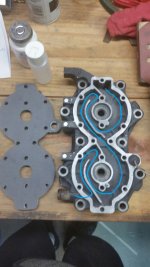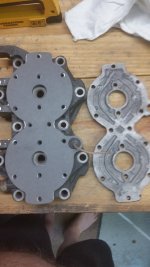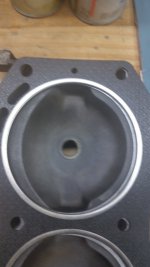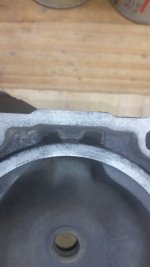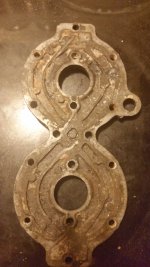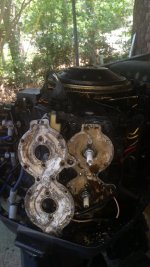I have searched everywhere I can think of.
If there ever was a gasket that was cut to allow water from the head to come in contact with the cover, it must have been discontinued long ago.
I can find only the one image (attached in an earlier post) that shows a gasket that would allow water contact with the cover.
I don't know what type of gasket was in the motor when I took it apart there was very little of it left.
All I know for sure is that unless you cut the gasket that is available today, water will never touch that cover unless the gasket fails due to water pressure pushing it out into those channels.
That gasket creates a closed water cooling system within the head, water enters the top from the block, circulates through the head and exits at the bottom into the thermostat housing finally to the exhaust housing from the thermostats.
Pictures show the head on the bench. The bench would represent the block indicating the two holes supply water from the block.
Blue line shows the water path. The top of the head then has that gray gasket placed on it, then the cover.
I can only assume that the gasket getting wet then drying will naturally collect the minerals through seepage and or wicking of the water through it.
The gasket would eventually act as a sponge as it gets weaker and retains more water. This would then allow the gasket to press further into the channels... that may account for the mineral deposits in those channels if this type gasket was used.
I run exclusively in salt water, the gaskets are cheap and the process of replacing them takes minimal time. I will replace them every couple years to try and prevent further deterioration of the covers.
The question was never about the water entering the head from the block (the two holes), it was about water contacting the cover that appears to be designed to have water contact.
With the available gasket there is simply no way for water contact to happen.
Also want to note the 2 holes in the Head Gasket to the Block (supposedly designed to supply water to the jackets) centered top and bottom have no associated pathway to the water jackets on these heads.
They simply dump back into the ring an inch away from the 2 supply holes through the gasket on the top feeding the head and to the thermostats at the bottom, they are literally doing nothing on this head.
I don't know if this is a SPL thing or what.
The gasket is clearly visible (could not get a good picture) through the 2 holes and when in place through that hole to that solid triangle between the 2 holes that are angled down towards the the head cooling channels.
This is where I would expect to see a hole drilled to the water jacket if this hole was to supply water to the jackets and then dump the water to the thermostats, as the design suggests that triangle would have to be level with the head surface and flat in order to seal a hole drilled there to have pressure.
The cover clearly has this pathway cut into it, but that gasket is solid there are no small holes in it at the top or bottom (as the picture shows with the bolts and gasket on the jacket cover), no possibility to feed those channels.
So no holes in the head to the jacket, no holes in the gasket to the cover but we do have holes in the head to block gasket that do nothing.
I see no way for water to get there directly from those holes in the
Head to Block Gasket or the Head to Jacket Gasket.
If I am missing something or my logic is flawed please let me know.




















